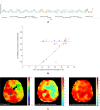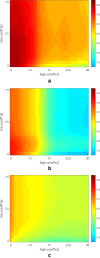Evaluation of the cerebrovascular reactivity in patients with Moyamoya Angiopathy by use of breath-hold fMRI: investigation of voxel-wise hemodynamic delay correction in comparison to [15O]water PET
- PMID: 36434312
- PMCID: PMC9905170
- DOI: 10.1007/s00234-022-03088-4
Evaluation of the cerebrovascular reactivity in patients with Moyamoya Angiopathy by use of breath-hold fMRI: investigation of voxel-wise hemodynamic delay correction in comparison to [15O]water PET
Abstract
Purpose: Patients with Moyamoya Angiopathy (MMA) require hemodynamic assessment to evaluate the risk of stroke. Hemodynamic evaluation by use of breath-hold-triggered fMRI (bh-fMRI) was proposed as a readily available alternative to the diagnostic standard [15O]water PET. Recent studies suggest voxel-wise hemodynamic delay correction in hypercapnia-triggered fMRI. The aim of this study was to evaluate the effect of delay correction of bh-fMRI in patients with MMA and to compare the results with [15O]water PET.
Methods: bh-fMRI data sets of 22 patients with MMA were evaluated without and with voxel-wise delay correction within different shift ranges and compared to the corresponding [15O]water PET data sets. The effects were evaluated combined and in subgroups of data sets with most severely impaired CVR (apparent steal phenomenon), data sets with territorial time delay, and data sets with neither steal phenomenon nor delay between vascular territories.
Results: The study revealed a high mean cross-correlation (r = 0.79, p < 0.001) between bh-fMRI and [15O]water PET. The correlation was strongly dependent on the choice of the shift range. Overall, no shift range revealed a significantly improved correlation between bh-fMRI and [15O]water PET compared to the correlation without delay correction. Delay correction within shift ranges with positive high high cutoff revealed a lower agreement between bh-fMRI and PET overall and in all subgroups.
Conclusion: Voxel-wise delay correction, in particular with shift ranges with high cutoff, should be used critically as it can lead to false-negative results in regions with impaired CVR and a lower correlation to the diagnostic standard [15O]water PET.
Keywords: Breath-hold fMRI; Cerebral perfusion reserve capacity; Cerebrovascular reactivity; Moyamoya Angiopathy; [15O]water PET.
© 2022. The Author(s).
Conflict of interest statement
The authors declare that they have no conflict of interest.
Figures






References
MeSH terms
Substances
LinkOut - more resources
Full Text Sources
Medical

